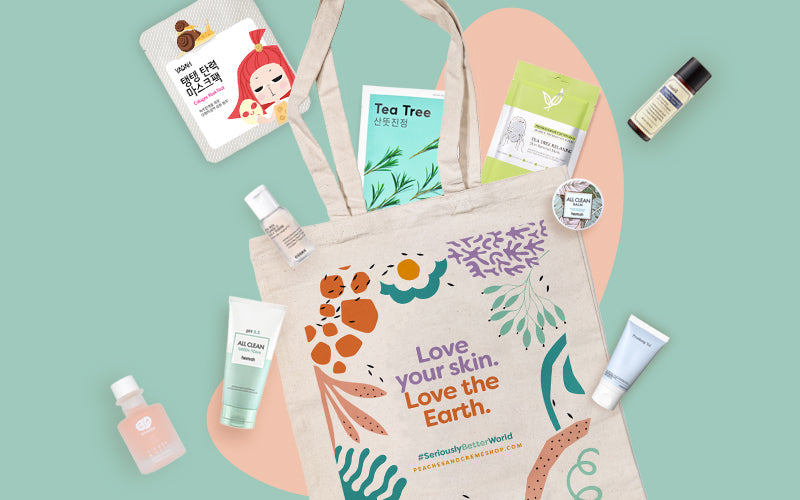All About Acids: Chemical Exfoliation Explained
Chemical exfoliants are acids that help speed up the skin's natural shedding process and helps fade skin imperfections like pigmentation, scars, even wrinkles. It's a great option for people with sensitive skin or those with active acne who are trying to avoid or cannot do physical exfoliation.
Are acids safe? Will it hurt my skin?
Chemical k-beauty exfoliants utilise gentle acids in low percentages. With regular use, they help speed up our skin’s natural process of shedding dead skin cells, revealing fresh, healthy, brighter, smoother skin. It can also help reduce the appearance of acne, pores, fine lines, and hyperpigmentation. Plus, a healthier skin surface also makes it better at fighting acne!
Chemical exfoliants are a great option come in the form cleansers, toners, serums and sometimes even moisturizers.
What are the types of chemical exfoliants?
Most chemical k-beauty exfoliants will contain AHAs, BHAs, PHAs, or a combination. These acids work to 'unglue' the bonds holding dull, dead skin on the surface. Once these bonds are broken, the skin sheds them off naturally. You will soon feel your skin becoming smoother, brighter, and more youthful (even without actually seeing the shedding off process!).
Here is our nifty guide skincare acids and how they can benefit your skin type or help you achieve your skincare concerns!
|
|
AHA |
BHA |
PHA |
|
Recommended skin type |
Normal to Dry skin
|
Normal to Combination to Oily skin and/or acne-prone
|
Normal to dry skin that have (ultra) sensitive skin
Darker skin tones
|
|
Skin concerns |
Sun-damaged skin
Less suitable for extra sensitive skin which is prone to break-outs and blackheads
|
Sensitive skin
Acne-prone skin
Breakouts
Blackheads
Millia
Rosacea-prone skin |
Skin types experiencing sensitivity/intolerance to AHAs and BHAs
Fine lines
Dullness
Enlarged pores
Post-inflammatory hyperpigmentation (post-acne marks/scars) |
|
Function |
Removes dead skin cells on the skin’s surface
Anti-aging properties to smooth wrinkles and fine lines
Hydrates and brightens the skin
|
Removes dead skin cells on the surface and deep within the pores
Unclog pores
Reduce oil production
Combats breakouts/acne, enlarged pores and blackheads
Hyperpigmentation
Prevent spots and acne from forming
Anti-inflammatory and anti-bacterial properties
|
Hydrating exfoliant
Has antioxidant properties
Fade post-inflammatory hyperpigmentation (post-acne marks/scars) |
|
Effectiveness for breakouts |
Can improve minor breakouts and clogged pores |
Can improve moderate & stubborn spots, breakouts and clogged pores |
|
|
pH level to work effectively |
Formulated at a pH between 3 and 4 |
Formulated at a pH between 3 and 4 |
Formulated at a pH between 3 and 4 |
AHAs (Alpha Hydroxy Acid)
AHAs are water soluble, so they only work on the skin’s surface. They are generally recommended for (and preferred by) those with normal to dry, sun-damaged skin due to their hydrating properties and ability to enhance the skin’s natural moisturising factors. They are also great in reducing the visible signs of sun damage and aging (like wrinkles and fine lines), and help even the skin's tone and texture. Perfect for normal to dry skin types.
Here are the types of AHAs and what skin type or concern are best match for each.
|
AHA |
Glycolic Acid |
Lactic acid |
Mandelic Acid |
|
Most suitable for |
All skin types |
Combination & Dry and sensitive skin |
Darker skin tones
(overly) Sensitive skin
Normal to dry skin
Acne prone skin |
|
Derived from |
Sugar cane |
Milk |
Bitter almonds |
|
Characteristics |
The most effective AHA due to is tiny molecule size giving it the ability to retexturize the skin with a smaller concentration than other acids. |
Is part of skin’s natural moisturizing factor (NMF). It’s hydrating because of its unique structure that allows it to bind water within skin
Can moisturise and exfoliate the skin at the same time
Milder version of glycolic acid |
Has a larger molecular structure (2x as glycolic acid), so it doesn’t penetrate the skin as deeply as glycolic acid does and ends up being less irritating and more tolerable especially to sensitive skin
light-sensitive - must be packaged in an opaque container to remain effective.
Most gentle AHA
|
|
Benefits |
For brighter, more even toned complexion
Significantly increases skin’s hydration and retain its moisture
Improves firmness of skin
Reducing signs of sun damage (such as wrinkles, fine lines) |
Strengthens skin’s barrier by encouraging it to make more ceramides
Fade signs of discoloration by hastening the shedding and renewal of surface cells that have a visible buildup of excess pigment |
less irritating and more tolerable especially to sensitive skin
Works well together with salicylic acid on darker skin tones for dealing with skin discoloration and post-acne marks
Strengthens collagen
Have antibacterial properties that help treat acne
Regulate sebum production and clears pores, and in turn decrease the occurrence of breakouts
|
|
Skin concern |
Dull skin
Sun damage
Uneven skin tone
Rough, flaky patches of skin
In higher concentrations, can improve the look of deeper wrinkles
|
Post-breakout/acne marks
Pink-to-red post-breakout marks
Sun-damaged skin, Fine lines & wrinkles
Rough texture |
Post-breakout/acne marks
Effective for inflammatory acne
Blackheads
Uneven/rough skin texture
Hyperpigmentation
Melasma |
|
Ph Level |
Formulated at a pH between 3 and 4 (the optimal range for it to exfoliate) |
Formulated at a pH between 3 and 4 (lactic acid will exfoliate skin if the pH is below 3, but a pH that low can cause irritation.) |
|
|
Concentration |
5 – 10% is ideal |
2% - ideal as hydrator 5-12% - ideal as exfoliant |
20-40% when used in a chemical peel |
NOTE: Citric acid (vitamin C) is an AHA. In the right formula and concentration, it can exfoliate skin at high concentrations (i.e. above 20%). Lactic and glycolic acid have been shown to be more effective and less likely to promote a stinging reaction on skin.
Here are some AHAs you can check out:
BHAs (Beta Hydroxy Acid)
BHAs, or commonly known as salicylic acid, are oil soluble, so they can penetrate deep inside the pores while also working on the skin’s surface. Because it is oil-soluble, it can dissolve all of the nasties, gunk, or anything else that can accumulate and clog deep within the pores - the ones that cause bumps and blemishes on skin’s surface. This can help treat acne by maximising absorption of other skincare treatment steps, and helping manage acne bacteria in the skin. This makes BHAs best suited for a range of skin types: normal, combination, oily skin, and skin that is prone to acne and blemishes, bumps, clogged and/or enlarged pores.
Another form of BHA is Betaine Salicylate which is a keratolytic BHA, similar to salicylic acid, which resurfaces skin, improving skin tone and texture. Unlike salicylic acid though, betaine salicylate is surprisingly gentle on the skin.
BHAs also have natural skin-calming and anti-inflammatory properties that are great for sensitive skin. Daily use of BHAs will visibly help:
- Refine pore size
- Alleviate bumps and clogs
- Soften the look of wrinkles
- Improve skin texture, tone, and hydration
- Restore a gorgeous glow
Talk about a multi-tasking acid ingredient!
Aside from AHAs and BHAs, you probably may have heard of another acid that is making a buzz in the skincare industry.
PHAs (Polyhydroxy acids)
PHAs are considered 'cousins' of alpha hydroxy acids, as they are in fact second-generation AHAs. The significant difference being PHAs have larger molecular structures. This limits their ability to penetrate the skin - but enables them to work exclusively on the surface without disturbing the deeper delicate layers. This lessens the potential for causing sensitizing side-effects, so the skin does not become more photo-sensitive or susceptible to damaging UV rays. They’re as effective as AHAs but less sensitizing, making it ideal for sensitive skin and those who are intolerant to AHAs and BHAs.
The most common PHAs are gluconolactone, galactose and lactobionic acid. PHAs can also function as antioxidants and may promote improvement in the skin’s surface strength.
As these chemical exfoliants have a range of benefits, a lot of k-beauty products actually feature a combination of two or three acids. Here are some examples:
Where do I start if I want to start chemical exfoliation?
How often you should exfoliate depends on your skin type and skin concerns.
Generally, it is recommended to exfoliate 2-3x a week. You can complement chemical exfoliation with physical exfoliation 1-2x a month if you can to give your skin a good boost to remove and whisk away all the dead skin cells that are sitting on the surface.
When starting out using AHAs, BHAs or PHAs, start slowly and gradually introduce and incorporate the chemical exfoliants in your routine. Start with once a week, then once every 2-3 days, before pushing the limits further. For example, you can try using your AHA or BHA once or twice a day on exfoliation days and find the balance that's right for you.
Dedicated chemical exfoliators are generally stronger, and that is why it is only recommended to be used 2-3x a week at most. However, there are products like toners with a lower concentration of acids that are gentle enough to be used daily. You can find them here.
How to use AHAs/BHAs/PHAs
Here's some things to remember when using your chemical exfoliators:
- It is best to apply your chemical exfoliators after cleansing and toning your skin. If your exfoliant product is in liquid form, apply it with a cotton pad; if it’s in lotion or gel form, apply it with your fingers.
- It is not recommended to use acids around the eye area especially on the eyelid or directly under the eye (along the lower lash line).
- You don't need to wait for your chemical exfoliant to completely dry or be absorbed by the skin. You can apply any other product in your routine - moisturiser, serum, eye cream, or sunscreen - immediately afterwards.
- Even within the same skin type, different people have different tolerances to acid ingredients. Experiment with different concentrations of AHAs or BHAs to see which concentration can be tolerated by your skin and which gives your skin the best results: You can use a different concentration in the morning and another at night; use them once or twice a week; or give yourself a refreshing peel by using a higher strength specialized AHA that delivers dramatic results.
- You can use AHAs and BHAs at the same time, either morning or evening, or alternating, depending on the combination of skin needs or concerns you are trying to address: advanced signs of sun damage, deep wrinkles, stubborn clogged pores and bumps, or dull, flaky skin. If you are experiencing more than one issue at the same time, then it’s best to use both an AHA and a BHA, one in the morning and the other at night.
- Don’t forget to use sunscreen if you use any acid in the morning!
There really isn't any downside to chemical exfoliation if you choose well-formulated, gentle ones. There isn't one best way to use them, either. Remember: Every skin is unique, and the key to making the best out of your Korean skincare routine is to try and see what works best for you.









Leave a comment